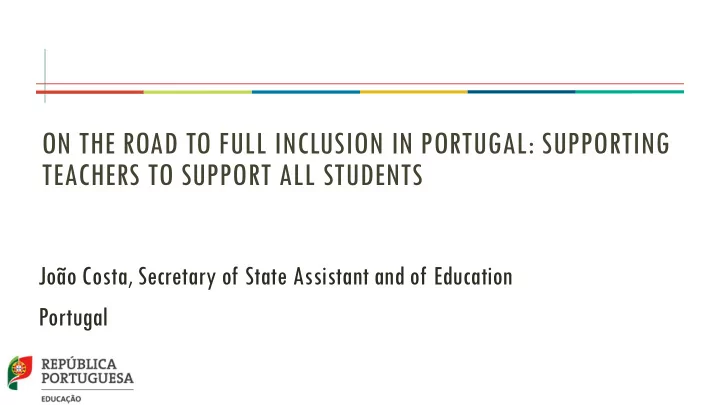

ON THE ROAD TO FULL INCLUSION IN PORTUGAL: SUPPORTING TEACHERS TO SUPPORT ALL STUDENTS João Costa, Secretary of State Assistant and of Education Portugal
FROM RETENTION TO THRIVING 1. The challenges for Portugal. 2. The ongoing measures. 3. The process: stakeholders, monitoring and tensions.
PORTUGAL 1974-2018 40 years of democratic school – 40 years of progress 1961 2016 Preschool attendance 0,9% 88,4% Transition to ISCED 2 7,5% 87,2% High-school enrollment 1,3% 75,2% Iliteracy 25,7% 5,2%
A 30 YEAR OLD PROCESS - 60s – From exclusion to segregation. - Late 90s – From segregation to integration - 2008 – Integration with resources - 2018 – From integration to full inclusion
MAJOR CHALLENGE 1. Retention and early drop out are still very high. 2. Almost 1/3 of the students do not conclude high school in expected time. Problem of justice and equity Poverty is the main predictor of retention
BACKGROUND FOR INCLUSION 1. Great experience in Portugal: the number 97,5! 2. Meaning of ALL 3. From clinical to educational model.
STRUCTURED RESPONSE Strategic action plans and municipal educational Essential In-service plans training Curriculum Evaluation Model Students’ Profile (Changes in National assessments) Program for Promoting School Success Curricular guidelines (PNPSE) Education Pre-school Strategy for Citizenship (Investment in Pre-school) Inclusive Qualifica education Program (New law for Autonomy and inclusion) Curriculum Flexibility
STRUCTURED RESPONSE What is a successful student? Areas of competence: Language and Texts Information and Communication Reasoning and Problem-solving Students’ Autonomy and Personal Development Critical and Creative Thinking Profile Scientific and Technological Knowledge Interpersonal Relationship Individual and Collective Well-Being and Health Aesthetic and Artistic Sensitivity Body Awareness and Domain
STRUCTURED RESPONSE Students’ Profile implies diversification of assessment instruments. - Focus on formative assessment. Evaluation - Introduction of performative assessment Model - Qualitative feedback on national assessment
STRUCTURED RESPONSE Curriculum overload problem Work developed with professional societies. Essential Same structure for every subject. curriculum Horizontalization of curriculum.
STRUCTURED RESPONSE Local solutions Project-based learning Autonomy Focus on interdisciplinarity and Technology , Arts and Citizenship as new or Curriculum reinforced domains Flexibility 25% flexibility in organization
STRUCTURED RESPONSE From integration to inclusion Departure from clinical model. Multilevel approach. Inclusive Personalized responses. education Multidiscplinary approach.
PRINCIPLES 1 . Schools being required to develop a documented framework for the creation of an inclusive school culture that values diversity. 2. School multi-disciplinary teams being responsible for raising awareness of the need for school cultural and process transformation at a whole-of-school level, while discharging their main function of identifying, evaluating and adjusting specific measures and strategies to support the learning of every student and overcoming barriers (including environmental) to every students’ individualised learning.
PRINCIPLES 3. Emphasis on autonomy and responsibility for inclusion at the individual school level – with external specialised support when required. 4. The principle of “customization” – student-centered differentiated educational planning so that measures are decided on a case-by-case basis according to their specific needs, potential, interests and preferences, through a multi-level graduated approach.
PRINCIPLES 4. Parents as well as teachers, have the right to initiate a multi-disciplinary team assessment of whether a student should be receiving additional support through selective or additional measures. 5. A general and strong emphasis on greater parental involvement as partners – with parents and guardians having the right to participation and information regarding all aspects of their child’s educational process – including participation in all multi- disciplinary team meetings, preparation and evaluation of individual education plans and access to their child’s school files and records.
PRINCIPLES 6. All students with individualised education plans are also to have individualised transition plans in place 3 years before the end of secondary schooling to promote transition to post-school life, including in employment and community.
THE PROCESS – STAKEHOLDER ENGAGEMENT 1. National survey on curriculum. 2. Working group for inclusive education. 3. National conferences with professional societies. 4. Consultation with parent associations. 5. Student Voice. 6. Core curriculum developed with teachers and academia. 7. Pilot year with volunteering schools.
THE PROCESS – MONITORING 1. Investment in proximity follow-up: regular meetings with school principals, visits to schools, technical back-up. 2. Regular collection of schools’ curricular options. 3. Practise sharing: videos, regional teams, school networks, panels with students. 4. Teacher training: seminars, MOOC, leadership training. 5. Publications. 6. National conferences. 7. Internal evaluation of the pilot by University of Oporto. 8. External review by OECD, European Commission – European Agency.
THE PROCESS – 3 IMPORTANT ASPECTS 1. New framework for School Quality Assessment 2. Inclusive approach to inclusion (ALL) 3. Student Voice and Human Rights Education
THE PROCESS – COPING WITH TENSIONS AND DIFFICULTIES Tensions/Dillemas Response Assessment (internal and Training on formative assessment external/international) Indepth evaluation of results of exams Public perception of purpose of school Good media coverage – lightouse schools Access to University ___ Disciplinary tradition Examples from citizenship, arts, local heritage Ageing teaching body ___ Curriculum overload Monitoring every two years / focus on mathematics Bureaucracy Evaluation / Good practise guide
Work in Progress Teacher training Constant follow-up – Evaluation of the law Production of indicators. Networking and collaboration
Recommend
More recommend